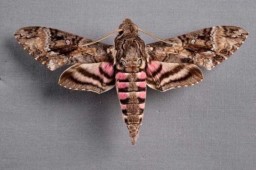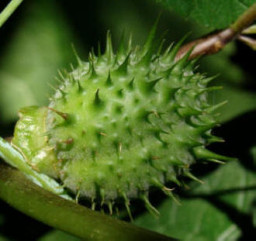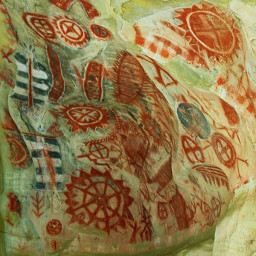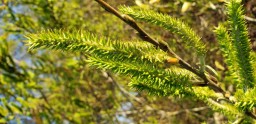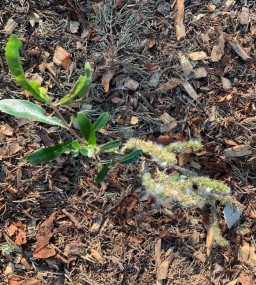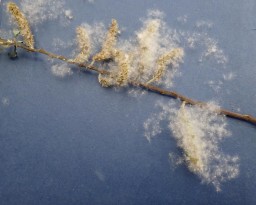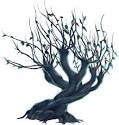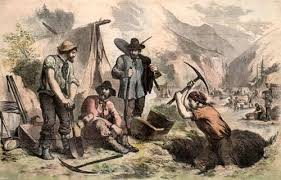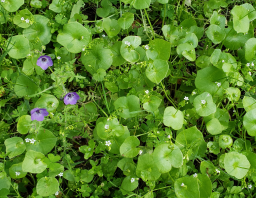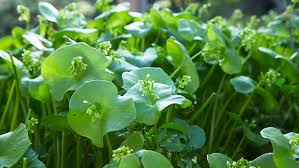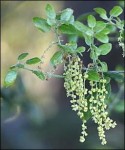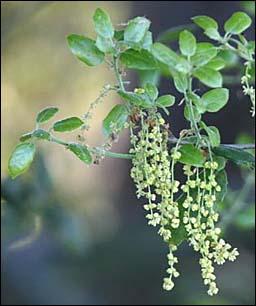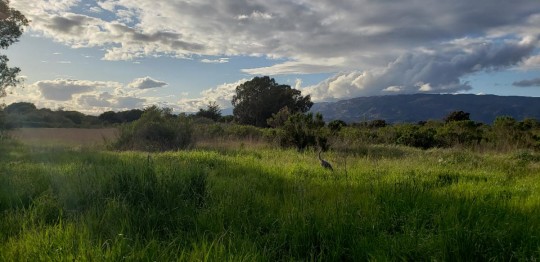
Photo by Chris Brems
Today’s Treasure May Be Flying, Wading or Standing Still – But Always Breathtaking
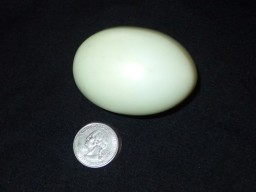
Today’s treasure starts with this lovely, pale blue egg. What emerges from this egg, after being incubated roughly a month? It’s a Great Blue Heron Chick!
During that month it will have been lovingly and periodically rolled (to keep its temperature constant) and “sat on” by both Mom and Dad. (Dad helps during the day, but Mom gets all the night duty.) The newborn will weigh about 1¾ ounces, and when it emerges, it may be surrounded by up to 5 other chicks who have hatched earlier. Nestlings can verbalize immediately and the parents will then feed them by regurgitating food they have gathered. Although the youngsters can leave the nest, and sit on a branch after only a few weeks, Mom and Dad will still feed for 49-81 days. After that, the nestlings are on their own.
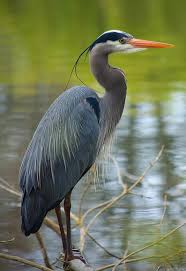 What do we know about the adult in addition to their being elegant royalty of the bird world? Full grown Great Blue males, at 50 inches tall, are the largest of the North American herons. Their wingspan can reach 80 inches. But all this height and wingspan weighs a mere 6-8 pounds because, as for all birds, their bones are hollow. They have long legs (see “Fun” below), an “S” shaped neck, a thick dagger-like bill and an amazing 9 inch stride.
What do we know about the adult in addition to their being elegant royalty of the bird world? Full grown Great Blue males, at 50 inches tall, are the largest of the North American herons. Their wingspan can reach 80 inches. But all this height and wingspan weighs a mere 6-8 pounds because, as for all birds, their bones are hollow. They have long legs (see “Fun” below), an “S” shaped neck, a thick dagger-like bill and an amazing 9 inch stride.
They Look Like and Move Like Royalty, but Eat Like a Peasant … Just About Anything
Great Blues are opportunistic feeders and hunt 90% of their waking hours. They will eat anything within striking distance: fish, amphibians, reptiles, small mammals, insects, and other birds. In freshwater creeks and ponds, as well as salt water lagoons, they grab smaller prey in their strong mandibles or use their dagger-like bills to impale larger fish, often shaking them to break or relax the sharp spines before gulping them down.
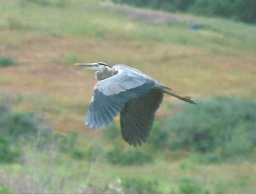
The Great Blue hunting style involves wading or standing like a statue. Moreover, they are very skittish, so approach slowly … or not at all. If they have perceived you as a threat, they will take off by beating their wings hard, catching the wind and then gracefully cruising at speeds of 20-30 mph. You may see Great Blue Herons on More Mesa this time of year because its wetland areas are well … wet … and therefore good hunting grounds. You can also see Great Blue Herons almost all year at Goleta Beach County Park.
Completing the Circle of Life
In order to complete their life cycle, adult Herons need to find mates, and produce eggs. Since the young are vulnerable to predators, Great Blue Herons generally choose to build their nests within 2 miles of feeding habitat, in high trees, and in large colonies consisting of other Great Blue Heron nests*. To start with, like many birds, Great Blue Herons have elaborate mating rituals where the male does most of the chasing, while the female sits in one place, sings a little and expects to be impressed. Male Great Blues perform by flying in huge circles around the colony and fighting off other competitors for the lady of their choice.
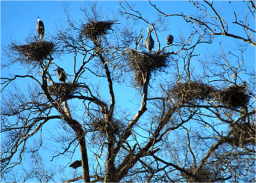
Once the monogamous pair (at least for that season) is formed, the nest must be built. This is an elaborate affair, with the male choosing the nest site and gathering materials. He presents the materials (usually twigs) to her and then lays them at her feet. At this point, the female takes responsibility for the creation of the nest. She uses the “gifts” the male brings her and either builds a new nest or uses the supplies to repair an old one. For the final touches, the female lines the nest with leaves and plants to create padding for the three to six eggs she will lay over the next 10 days or so. Viola! Back to the egg!
*They are called heronries and you can look for one at Goleta Beach Park.
A Fun Thing to Think About
Birds have legs with all the same structures as we have. But there are some big surprises. The sketch at the right, with the parts of the leg illustrated, shows that: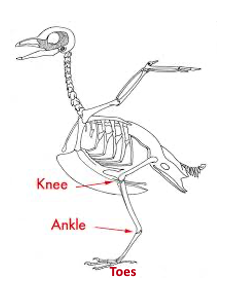
- Birds walk only on their toes
- Their feet never touch the ground when walking
- Their ankles are in the middle of their legs
- Their knees are up under their feathers where you can’t see them!
How Can I Identify Things I See on More Mesa?
 Three guides, “Birds”, “Insects” and “Plants” have been created and uploaded to our web site. And, since our web site is mobile friendly, these guides are especially useful when citizen scientists and other visitors to More Mesa are in the field. So … when you are out enjoying lovely More Mesa and see something you want to identify immediately, grab your smart phone, bring up our web site and look for the appropriate Guide; Birds, Insects (includes butterflies) or Plants. It’s the perfect option!
Three guides, “Birds”, “Insects” and “Plants” have been created and uploaded to our web site. And, since our web site is mobile friendly, these guides are especially useful when citizen scientists and other visitors to More Mesa are in the field. So … when you are out enjoying lovely More Mesa and see something you want to identify immediately, grab your smart phone, bring up our web site and look for the appropriate Guide; Birds, Insects (includes butterflies) or Plants. It’s the perfect option!
Remember: Six Feet Apart and Stay Safe,
Valerie


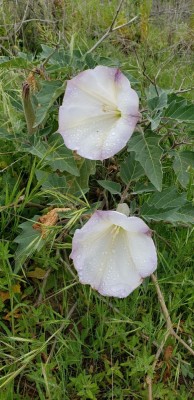 The plant we are featuring in this hunt, commonly known as Datura, and in the Nightshade family, is unusual in many ways. First it has several names, among them: Devil’s Trumpet, Devil’s Weed and Jimson Weed*. And, unlike the Miner’s Lettuce and Willow of previous Treasure Hunts, Datura thrives in dry, temperate and subtropical regions like the American Southwest and Mexico, which is considered the center of its origin. This amazing Datura photo, was taken by Chris Brems on the eastern coastal trail where the paragliders lift off. (Plaque in the ground at this spot reads “Hook In”.) The photo illustrates the fascinating process described in the story below.
The plant we are featuring in this hunt, commonly known as Datura, and in the Nightshade family, is unusual in many ways. First it has several names, among them: Devil’s Trumpet, Devil’s Weed and Jimson Weed*. And, unlike the Miner’s Lettuce and Willow of previous Treasure Hunts, Datura thrives in dry, temperate and subtropical regions like the American Southwest and Mexico, which is considered the center of its origin. This amazing Datura photo, was taken by Chris Brems on the eastern coastal trail where the paragliders lift off. (Plaque in the ground at this spot reads “Hook In”.) The photo illustrates the fascinating process described in the story below.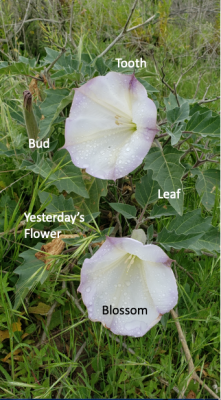 What we saw … as we giggled at the idea of watching a plant … was a furled bud sticking up in the air. It looked like it was bound up with some tiny “hooks”. Then, within a few minutes, the bud began to unfurl, one hook at a time. We were stunned! You could almost hear it going click, click, click as it unfolded into a beautiful trumpet-like flower. It was the Sacred Datura, also called Moonflower, because it blooms late in the afternoon, is pollinized at night, and closes by noon of the following day. While each individual flower lasts only a single night, during any given summer season, one Sacred Datura plant produces dozens of large (6-8 inches), fragrant, whitish (sometimes purple edged) flowers, each with five of the slender hooks that are called “teeth”.
What we saw … as we giggled at the idea of watching a plant … was a furled bud sticking up in the air. It looked like it was bound up with some tiny “hooks”. Then, within a few minutes, the bud began to unfurl, one hook at a time. We were stunned! You could almost hear it going click, click, click as it unfolded into a beautiful trumpet-like flower. It was the Sacred Datura, also called Moonflower, because it blooms late in the afternoon, is pollinized at night, and closes by noon of the following day. While each individual flower lasts only a single night, during any given summer season, one Sacred Datura plant produces dozens of large (6-8 inches), fragrant, whitish (sometimes purple edged) flowers, each with five of the slender hooks that are called “teeth”.